Island Chronicles, vol. 16 – A Break From Beatlemania: The Beatles At Key West, 1964
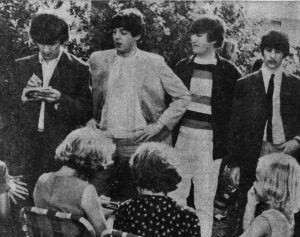
Welcome to “Island Chronicles,” the Florida Keys History Center’s monthly feature dedicated to investigating and sharing events from the history of Monroe County, Florida. These pieces draw from a variety of sources, but our primary well is the FKHC’s archive of documents, photographs, diaries, newspapers, maps, and other historical materials.
By Corey Malcom, PhD
Lead Historian, Florida Keys History Center
Beatlemania
The Beatles – Paul McCartney, George Harrison, Ringo Starr, and John Lennon – were four young musicians from Liverpool, England, who burst onto the music scene in 1963 by playing a new and fresh version of rock and roll. Not only was their music different, but the band members looked and behaved differently from what most people were used to. They had long hair and were confident, funny, brash, and good-looking, a combination that gave them a special something that drove teenage girls wild and made boys want to be like them. Fans hung on their every song and word. As their popularity grew, passionate, energetic crowds followed. The band was hounded relentlessly, and chaos ensued just about everywhere they went. The term “Beatlemania” was invented to describe the phenomenon.
As Beatlemania began to cross the Atlantic at the end of 1963, it came at a time ripe for change. With the recent assassination of President John F. Kennedy, the social upheavals of the civil rights movement, and increasing U.S. military involvement in Viet Nam, many people in the U.S., especially youth, were longing for a shift of direction. The Beatles became both genuine and symbolic agents of change, and in many ways, they helped steer young people to places they wanted to go but had never been.
The Beatles first visited the U.S. in February of 1964. They performed sold-out concerts in Washington, D.C., and New York City, and they appeared twice on the Ed Sullivan television show. For one of their Sullivan appearances, 73 million viewers tuned in, then the largest TV audience ever. Later in the year, to capitalize on their earlier American success, a longer visit was devised: From August 19 to September 20, 1964, the Beatles embarked on a tour of the United States and Canada to perform 32 shows in 25 cities. The shows were revue-style, in that multiple musical acts performed. The openers were the singers and bands The Exciters, Jackie DeShannon, Clarence “Frogman” Henry, and Bill Black’s Combo; the Beatles then headlined the extravaganza. As the tour unfolded, American Beatlemania kicked into high gear, and everywhere the bands went, chaos, good and bad, erupted.
September 8
On Tuesday September 8, 1964, the local news headlines of the Key West Citizen were mundane, telling of the expected turnout for the day’s special election, the opening of a new bridge to Fleming Key, and deteriorating conditions at the Big Coppitt Key Cemetery. The top headline, though, concerned Hurricane Dora, which was churning in the Western Atlantic and was making its way toward North Florida. The Jacksonville area was expected to feel the first winds and rain as early as the coming overnight hours.[1] Little did anyone know the hurricane would impact the Florida Keys, too, albeit in a much different way.
Nearly 1,800 miles away in Montreal, Canada, the Beatles wrapped up the 21st show of their tour. There had been trouble at the stop – death threats had been made against the group by French-Canadian separatists, requiring extra police and sharpshooters to be on hand for the performance. And afterwards, anti-Semitic threats were made against Ringo Starr (who is not Jewish), prompting the band to want to leave: George Harrison remembered, “A Montreal newspaper reported that somebody was going to kill Ringo. Because they didn’t like his nose or something? … I don’t know. Anyway, we decided, ‘F**k this, let’s get out of town…” [2]
The band’s next performance was scheduled for September 11 in Jacksonville, Florida, and everyone was looking forward to the break between shows. The two-day gap was also needed because, despite the passage of the Civil Rights Act two months earlier, segregation was still a reality in Jacksonville, and audiences in the municipally owned Gator Bowl continued to be separated by color. The Beatles refused to go along with the policy, though, and said they would not perform to a segregated audience. In an interview with the London Daily Express, John Lennon said plainly, “We never play to segregated audiences and we aren’t going to start now…I’d sooner lose our appearance money.”[3] There was much behind-the-scenes discussion going on to resolve the Jacksonville situation, but there was a good chance the show there would not happen.
Now, with a hurricane approaching, it made no sense to go to Jacksonville, anyway. A new location was sought for the two-day break, and because they were coming from Canada, it had to have an international airport with customs and immigration services. The Beatles team scrambled to find a solution. Miami journalist Larry Kane, who was traveling with the group, suggested Key West to Beatles manager Brian Epstein.[4] Epstein thought a respite in the remote subtropical island city sounded like a good option, and he had Ruby Hickman, the tour’s “Airline Associate” who arranged the group’s flights, begin to find accommodations. She remembered, “On the night of the hurricane, the plane was a hub of activity. I explained the problem to Ira Sidelle, the travel agent with us, and to others responsible for various arrangements. They dashed for phones. At some point I explained the situation to the Beatles. Someone suggested we fly to the Bahamas. Without explaining all the hours of turmoil preceding the decision or the conditions that had to be met, I answered firmly (maybe even a little shortly), ‘No, I’m not taking you in and out of another country right now. You’re going to Key West.’”[5] After all the necessary arrangements were made, the 35-person Beatles entourage boarded their chartered plane for the six-hour, 1800-mile flight to the island city.
By 9:30 p.m., word began to spread around Key West that the Beatles were coming and that they had booked rooms at the Key Wester Resort, adjacent to the airport on South Roosevelt Boulevard.[6] Wily reporters with the Key West Citizen used their connections with local air traffic controllers to track the plane as it made its way south.[7] Around 10 p.m., Bruce Holton, the U.S. Immigration agent at Key West, pre-approved the group’s customs and immigration declarations for what would be a middle-of-the-night arrival.[8] At much the same time, Key West Beatles fans began to gather at the airport, most of whom had had to coax their parents into driving them there.
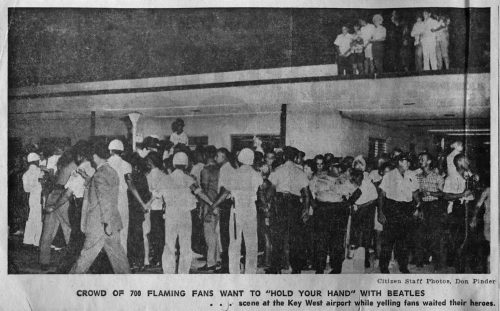
Fans gather at the Key West Airport, waiting for the arrival of the Beatles. Key West Citizen, September 9, 1964.
In the air, the Beatles had fun. As Ruby Hickman noted, “The flights were, in reality, the only time the Beatles could relax and feel safe – 30,000 feet in the air.” Someone in the entourage found they could remove the headrest pillows, and a large-scale pillow fight broke out, with Paul McCartney calling a play-by-play of the fracas over the cabin’s PA system.[9] But the exuberance faded as they approached Hurricane Dora, and the plane began to be buffeted by wind; some passengers got airsick. They completed the journey safely, though, and George Harrison described how it ended, “We got on the plane to Jacksonville, Florida. But we found that there was a hurricane hitting Jacksonville, so they diverted us to Key West, announcing, ‘Fasten your seat belts. The runway isn’t big enough for this plane. We’re going to have to go in with full reverse thrust.’ This was on an Electra, a plane that we later discovered has a very high accident record. But we landed at Key West all right and had our day off there.”[10]
A crowd of over 700 Key West Beatles fans had gathered at the airport; they lined the arrival gate, and some even climbed to the terminal roof, hoping for a better view of the band. Their vehicles filled the airport grounds all the way to South Roosevelt Boulevard. Most of the Key West Police force, backed up by the Sheriff’s department, the Florida Highway Patrol, and elements of the Navy’s shore patrol, were there to provide security. Mayor Kermit Lewin arrived to offer the famous guests a formal welcome to the city. When airport manager George Faraldo announced the Beatles’ expected arrival time, “a wail and sob arose from the spectators that would have done justice to Ghandi’s funeral,” wrote the reporter for the Citizen.[11] Before the plane landed, a pregnant fan went into labor in her friend’s car. When the police suggested to the friend that she drive the expectant mother to the hospital, she told them, “Oh, I can’t. I haven’t seen the Beatles yet.”[12]
September 9
The Beatles and their entourage arrived at Key West at 3:30 in the morning. No one knew that the immigration paperwork was already done, so it took an extra hour to find and awaken a border patrolman to allow the group to deplane. As the Beatles came down the gangway, the crowd erupted into screams of excitement. The four Beatles were quickly whisked into a police car driven by Lt. Nilo Albury. Girls threw themselves onto the cruiser to prevent it from leaving, but Albury and his precious charges managed to get away, and they dashed over to the nearby Key Wester Hotel. For the next two days, The Beatles would have nothing to do except enjoy their break in Key West and the Florida Keys.

John Lennon, George Harrison, and Paul McCartney immediately after their arrival at Key West, Key West Citizen, September 9, 1964.

The Beatles in a Key West Police car awaiting transport to the Key Wester Hotel. Key West Citizen, September 9, 1964.
The Beatles were given villas that fronted South Roosevelt Boulevard, and fans stationed themselves along the road and kept vigil, waiting for a glimpse of their idols. The Key West Beatlemaniacs were a mixed lot, of all ages and with different aims. Sixteen-year-old Key Wester Bonnie Tobin said, “I’m not one of the screaming types. Those are the bugged fanatics. I’m just one of their strongest fans, and I’d like to get their autographs.” Peacon Lane grandmother Bernette Creel said she “represented the family interest” and was watching for the Beatles in her granddaughter’s stead. “But I like the Beatles, too. I think they’re great,” she added. And Sandra Scott, 20, of George Street was there with her daughters, an infant and a two-year-old. Scott said she had been “waiting to catch sight of them since morning. We went home for lunch, but we came right back.”[13] Though the Key West fans were generally well-behaved, police were on duty night and day to keep any overly zealous devotees at bay.
The Beatles and their entourage slept late. When they woke, necessities like laundry had to be taken care of, and management sent $327 worth of washing out to a local laundromat. The Beatles intended to relax during their time off from the tour, and while a “crew of writers, publicity assistants, and others connected with the entertainers” toured the island on the Conch Train, the boys managed to quietly enjoy themselves. Paul went on a sight-seeing tour in a borrowed Cadillac, and George went swimming in the hotel pool (with a police guard watching). The musicians were scheduled to go on a glassbottom boat tour in the afternoon, but it does not appear that it happened.[14] At 5, a hungry Ringo perplexed the Key Wester’s kitchen staff by ordering “porridge.” None of the cooks had any idea what that meant, so they prepared a bowl of oatmeal for him. It was received without complaint.[15]
At some point, John Lennon ventured downtown and went shopping at Leed’s Credit Clothiers on Duval Street. He had a photo shoot for Cosmopolitan Magazine scheduled and needed some clothes for the occasion. Fans spotted Lennon and mobbed him on the sidewalk. After graciously signing several autographs, he was able to make his way into the store, and the doors were quickly locked behind so he could shop in peace. Salesgirl Mercedes Leon had the thrill of taking his measurements (neck size 15½), and clerk Cecilia May helped him select four shirts (three striped and one polka-dotted, all medium-sized), a pair of black socks, and three pairs of white “skivvies.”[16]
The Beatles also spent time with their tour mates, and Clarence “Frogman” Henry remembered hanging with them in Key West: “We stayed in a hotel and just viewed the city, and we got to be a little closer then. Paul, he was my main Beatle that was real friendly, he’d ask me about different New Orleans musicians. He and I and one of the guys with the Bill Black Combo, we bummed together. We had a nice time in Key West; I don’t think anyone knew we were down there.”[17]
By the evening of the 9th, everyone in the Beatles’ entourage was ready to party. John Trusty, a Navy corpsman stationed at the Naval Hospital on South Roosevelt Boulevard, not far from the Key Wester, was a witness to the events, and his account is the best of record of how things unfolded that night.[18] Trusty and his colleagues had heard that the Beatles were in Key West and were staying at the Key Wester, so that evening, after he had scrounged enough money for drinks from his barrack mates, Trusty and a buddy walked the three-quarters of a mile around the bend to the hotel. As the two men approached, they saw “a spectacular and wonderful sight unfolding before our eyes. There were girls in bikinis everywhere… The police tried to keep the girls out of the cordoned off area around the villas. It was like trying to keep a colony of ants from getting to a sugar cube.”
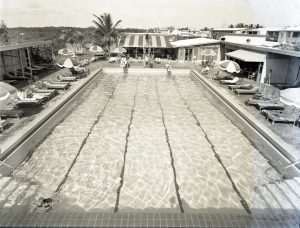
The swimming pool at the Key Wester Resort ca. 1960. Wright Langley Collection.
Trusty and his friend went around the crowd to the back of the property to enter the restaurant, but security stopped them. But because they were regulars at the hotel’s Carousel Lounge, a staff member recognized them and let them in. After they entered the lounge, they made their way to the bar. While turning around after being served, Trusty literally bumped into Paul McCartney and nearly spilled both of their drinks. After giving a quick nod and wink to acknowledge things were OK, McCartney began to work the room and flirt with the many young women there. “I had to admire his technique. He was magnificent in action as he went chatting up one girl after another, looking for that right combination of looks, willingness, and response,” marveled Trusty.
John Trusty was also on the prowl that night, and he heard Jackie DeShannon was outside by the pool. Hoping for a chance with the striking blonde singer, he left the lounge and went to the adjacent pool deck. DeShannon was not there, but what Trusty saw knocked him for a loop, and it spoke to the open-mindedness of the Beatles. There in front of him was “Ringo having a great time in the pool, just him and the female Black vocal group, the Exciters.” It was enough that Trusty had never seen a Black woman in a bathing suit before, but the added sight of three Black women in a pool with a white man absolutely shocked him. “The scene was very surreal to me, given the racial climate of America at the time. The Beatles were way ahead of the curve as it pertained to integration,” he said.
Back in the bar, Clarence “Frogman” Henry and members of Bill Black’s Combo played on a small riser. Key West musician Coffee Butler had come from the downtown Bamboo Room to accompany them. “I can’t remember what they played, but the house was rocking all night,” said Trusty. He did not see any of the Beatles play, but he heard later that Ringo joined with the band before the bar closed.
John Trusty also met John Lennon at the bar that night, and in their brief exchange he suffered a bit of cultural confusion. Trusty was nervous, and as the two men stood side by side, neither said a word. Finally, Lennon, who was smoking, offered a cigarette: “Would you like a fag”,” he asked, using British slang. “I was totally unprepared for the question. In this country, especially in Key West, even back then, to me there was only one meaning,” said Trusty. All he could think to say was, “No thanks man, I’m just here to pick up the chicks!” Lennon wished him luck and walked off with his Scotch and Coke.
Trusty and his friend once again spied Paul McCartney and drunkenly went up to him. Trusty’s pal pulled a Kodak Instamatic camera out of his sock and took a picture, violating a strict “no photos” rule that had been outlined to them before they entered. As soon as the flash went off, they were grabbed by security, the camera was smashed, and they were tossed out the door.
For everyone else, the party ended when the police showed up at 4 a.m. The crowd was reluctant for the night to end, so the bartender tried to enlist Paul into urging everyone to go home. McCartney blithely said he understood but kept drinking. The police finally managed to convince Coffee Butler that it was time to close. He wrapped up the song “Blueberry Hill,” stood up from the piano, and announced, “Time to split, fellas – these cats mean it!”[19]
September 10
The next day, the members of the Beatles continued to explore and enjoy the Keys. In the morning, John had his photo shoot for Cosmopolitan with Los Angeles photographer Ron Joy. He posed in the shirts he had purchased downtown, and a shot of him in a red, white, and black striped pullover made the cover. Afterward, John and management assistants Derek Taylor and Neil Aspinall, accompanied by photographer Curt Gunther, piled into a convertible and drove to Key Largo.[20] Photos suggest he took a boat ride.
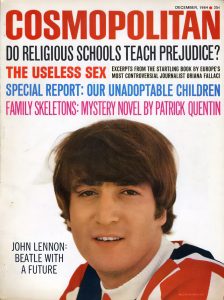
John Lennon on the cover of the December 1964 Cosmopolitan Magazine in a photo taken at Key West by Ron Joy. FKHC Collection.
When the car stopped at a Summerland Key gas station, a school bus full of students was there, gassing up, and when the kids realized who was in the neighboring vehicle, they started screaming, “Beatle, Beatle!” But, to their chagrin, the driver stoneheartedly started the bus and drove away.[21] Word of Lennon’s Summerland pit stop spread, and, as fast as they could get there, other local fans descended on the station. John posed for a photo, despite Taylor and Aspinall saying it was not allowed. When they were done, the Beatle and his escorts made their way back to Key West.
The other Beatles had a quieter day. Paul McCartney and George Harrison ventured to Sugarloaf Key, where they were the guests of the Papy family. Their getaway was made quietly, so the two were able to lounge around the pool at the politically influential family’s luxurious waterfront estate with no fans popping up to bother them.[22] Ringo spent the day laying low at the Key Wester.
In the evening, the group had a “homemade” meal prepared by Jerneice Reid, the mother of Brenda Reid, lead singer for the Exciters. Lillian Walker-Moss, another member of the Exciters, described the occasion: “We were down in Key West, Florida – they were complaining that they were tired of eating hotel food… ‘We want some good ole’ fish and chips… and real home cooking.’ … The Beatles stayed in a villa, and we stayed in a hotel with a big, beautiful suite. So, Brenda’s mother promised them she would make them food. …I don’t remember [the details] but it was a big spread. I remember we went to the supermarket and bought all of this food. They were so delighted.”[23] In an interview, Ringo would say that of all the American cuisine he had on the 1964 tour, “The only good meal he had on these shores was the Southern fried chicken whipped up in Key West by Mrs. Jerneice Reid.”[24]
As had become usual, hundreds of fans stood outside the Key Wester, chanting “We want the Beatles; we want the Beatles.” An enterprising ice cream truck driver was parked nearby, making a fortune. At 9 o’clock, implementing a rarely enforced curfew, the police made everyone leave. Once things settled down, the Beatles went for a late-night swim. At 1 a.m., George, Ringo, and Paul were all in the water, having a good time. John, wearing sunglasses, was sitting off by himself at a poolside table. It began to rain, so everyone gathered under a patio umbrella. With the weather having become uncooperative for swimming, they decided to leave the pool and reconvene in the bar.
An unnamed “rhythm combo” (likely consisting of members of Bill Black’s group) was playing in the Carousel Lounge. But when the Beatles walked in, they wanted to play. Paul and George grabbed guitars, Ringo got behind the drums, and tourmate Clarence “Frogmouth” Henry sang. A reporter described the music as “gutsy blues,” noting “the walls throbbed, and the lemonade flowed” until police, once again, stopped the party at four o’clock.[25]
“The Night We Cried”
It is well documented that the Beatles drank quite a bit while they were in Key West, and after one of their late-night benders, McCartney and John Lennon returned to their room at the Key Wester and let it all out emotionally, acknowledging their bonds in a way they had never done before. Paul McCartney has spoken about the occasion many times, and he remembers it as an “emotional landmark” for the two normally inexpressive friends.[26]
In an interview with Sirius XM’s “Beatle Channel,” McCartney explained what happened that night: “That was to do with a time when we were in Key West down in Florida, and for some reason, I think it was like a hurricane, something had been delayed, and we couldn’t play for a couple of days. So, we holed up in a little motel. So, what would we do? Well, we’d have a drink, and we would get drunk. We didn’t have to play. [We] got drunk and started to get kind of emotional, you know, ‘Oh, you were great when you –– I love that.’ We started, [and] it all came out. … On the way to that, there was a lot of soul-searching. We told each other a few truths. … ‘Well, I love you. I love you, man. I love that you said that. I love you.’ And we opened up. So that was kind of special to me. I think that was really one of the only times that ever happened.”[27]
The poignant moment even made its way into his music. In the song “Here Today,” a 1981 paean to the recently murdered Lennon, he refers to their Key West confessional with the lyrics “What about the night we cried / Because there wasn’t any reason left to keep it all inside.” McCartney told Esquire magazine that when he performs “Here Today,” the night in Key West comes back to him. “Obviously, when I do ‘Here Today’ as I do, that is very personal. That is me talking to John. But as you sing [lyrics] you review them. So I go, [sings] “What about the night we cried?” And I’m thinking, “Oh, yeah: Key West”. We were all drunk. We’d delayed Jacksonville because of a hurricane. We got parked in Key West and we stayed up all night and we got drunk – ‘Let me tell you, man, you’re f____g great’ – so I know that’s what I’m talking about. I know the night. I do think of that.”[28]
The End
On September 11, Hurricane Dora was gone, and word had arrived that the Jacksonville concert promoters had agreed to an integrated show. It was time to move on to the next stop, so the Beatles prepared to leave. The band had not done any formal interviews while in Key West, but they did agree to a short question-and-answer session late that morning with 12-year-old Suzen Monahan and her friend Jeannie Jones. Suzen was the daughter of Florida State Road Department board member John Monahan, who had somehow used his influence to arrange the visit with his daughter. They were joined by a few other girls, mostly the daughters of Keys politicians.
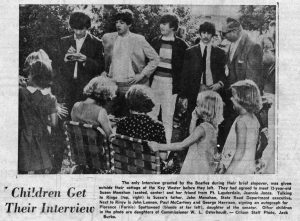
The Beatles speak with Suzen Monahan and other girls in front of the Key Wester Hotel. Key West Citizen, September 13, 1964, p1. FKHC Collection.
Derek Taylor, the Beatles tour manager, told the Key West Citizen the band was grateful for the (relative) peacefulness of their island stay. Taylor noted that, generally, the band seldom had a moment to relax, but “the Key West people, however, have been wonderfully cooperative,” he said. “The Beatles appreciate this and love Key West for this attitude.” Taylor also had high praise for the Key West Police Department: “They are gentle and courteous; unlike any other policemen we have encountered in the United States.” And, he added, “We were all greatly impressed by the beauty of the Keys. We didn’t realize the distance from Miami by the road, of course. We much prefer it here than Miami.”[29]
In the early afternoon, the group made the short trip from the Key Wester to the airport, boarded their plane, and flew off to Jacksonville. Their break was over. But for 60 hours, the Beatles had brought a special magic to Key West and the Florida Keys, and by all accounts the islands had done the same for them.
[1] Associated Press (1964). “Hurricane Dora Perils Upper Florida,” Key West Citizen, September 8, p1.
[2] The Beatles (2000). The Beatles Anthology, Chronicle Books, San Francisco, p.153
[3] Gunderson, C. (2020). “The Untold Story of the Beatles’ Desegregation Rider” at www.culturesonar.com/the-untold-story-of-the-beatles-desegregation-rider/.
[4] Kane, Larry (2003). Ticket to Ride: Inside the Beatles’ 1964 Tour that Changed the World. Running Press, Philadelphia, p.100.
[5] Hickman, R. (1984). “On the Road with The Beatles,” The Write Thing, Issue #42. Republished at www.meetthebeatlesforreal.com/2014/09/traveling-with-beatles.html
[6] Jacobsen, Bud (1964). “Mainland Gets Dora – We Get Beatles” Key West Citizen, September 9, p1.
[7] Ibid., p4.
[8] Anonymous (1964). “Beatle Watching” Key West Citizen, September 10, p1.
[9] Long John Wade (n.d.) “Go with the Beatles Across the U.S. A.” at www.meetthebeatlesforreal.com/2014/11/go-with-beatles-across-us-a.html
[10] The Beatles (2000). Op.cit.
[11] Jacobsen, Bud (1964). “Beatles,” Key West Citizen, September 9, p.4.
[12] Anonymous (1964). “Here and There.” Key West Citizen, September 9, p.1.
[13] Jacobsen, Bud (1964). “What Causes Beatle-Mania?” Key West Citizen, September 11, pp. 1 & 7.
[14] Anonymous (1964). “It’s An Ill Wind…” Key West Citizen, September 9, p.1.
[15] “Beatle Watching.” Key West Citizen, September 10, 1964, p.1
[16] Raymer, Dorothy (1964). “John Goes Shopping, Thrills Salesgirls,” Key West Citizen, September 10, p.1. It is not clear if this happened on the 9th or the 10th, though Raymer’s account hints at the earlier date.
[17] Irrera, Joseph (2024). Clarence “Frogman” Henry (1937-2024), Offbeat Magazine, April 8. At: https://www.offbeat.com/news/clarence-frogman-henry/
[18] Trusty, John (2006). “I’m Just Here to Pick Up Chicks!” Beatleology Magazine, Nov/Dec, 2006. Republished at http://www.meetthebeatlesforreal.com/2014/09/im-just-here-to-pick-up-chicks.html
[19] Sann, Paul (1964). “The Beatles, the Intimate Portrait.” The New York Post Daily Magazine, September 16, p.21.
[20] Kealing, Bob (2023). Good Day Sunshine State: How the Beatles Rocked Florida, University of Florida Press, Gainesville, p.179.
[21] Parks, Pat (1964). Visiting along the Lower Keys, Key West Citizen, September 15, p.8.
[22] Kealing, op.cit.
[23] Wakler-Moss, Lillian (2018). “Lillian Walker-Moss – The Exciters. 1964 Beatles US Tour.” At https://musicguy247.typepad.com/my-blog/lillian-walker-moss-the-exciters-1964-beatles-us-tour/
[24] Sann, Paul (1964). “The Beatles, the Intimate Portrait.” The New York Post Daily Magazine, September 16, p.21.
[25] Barrett, Bill (1964). “Beatles Frolic at Party,” Cleveland Press. Republished at http://www.meetthebeatlesforreal.com/2022/06/beatles-frolic-at-party.html
[26] https://www.npr.org/2010/10/08/130425878/beatle-paul-mccartney-remembers-john-lennon
[27] https://ultimateclassicrock.com/paul-mccartney-here-today/
[28] Bilmes, Alex (2015). “Paul McCartney Opens Up About Lennon, Yoko, and More.” At https://www.esquire.com/entertainment/interviews/a36194/paul-mccartney-interview/
[29] Raymer, Dorothy (1964). “Life With The Beatles Has Few Quiet Moments.” The Key West Citizen, September 11, p.7.
Did you miss any of the earlier volumes of Island Chronicles? You can find them here.